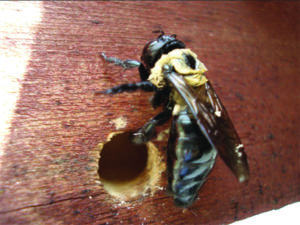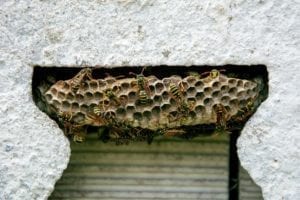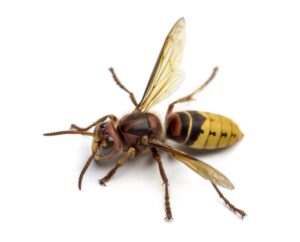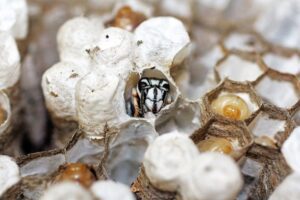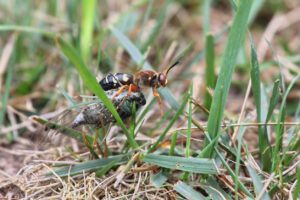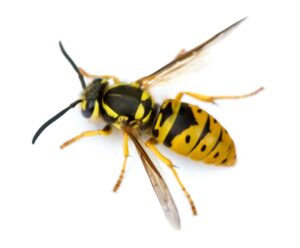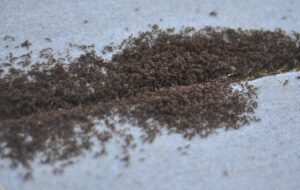Stinging insect season is upon us. Although some species are a nuisance to us, insects like wasps, bees, and ants have a very special place in our ecosystem. Stinging insects pollinate plants, keep the food chain functioning, and act as decomposers in our environment.
Did you know that one third of all crops in the world are pollinated by insects?
Stinging Insect Season 101
Written by Allison Beach, Technical Specialist, Rose Pest Solutions
Bees and wasps provide many benefits to humans from a big picture standpoint, but with two big downsides: they do damage to our homes AND they sting us. In this article, we are breaking down which ones are better left alone, which ones do damage, and how to reduce your risk of getting stung.
Why do they sting?
Insects typically sting humans only if they feel threatened or feel the need to defend their colony or nest. Despite what we tend to believe, they NEVER seek humans out to sting, unprovoked. In addition, some need a lot of human interference to feel threatened, while some do not.
Here are some tips on how to reduce your risk of getting stung this stinging insect season:
- Bathe daily (sweat may anger bees).
- Avoid perfumed soaps, shampoos, and deodorants if you will be outdoors.
- Wear light-colored, clean clothing that covers as much of the body as possible.
- Keep drinks, food, and garbage cans covered while outdoors.
What to do if you get stung this stinging insect season
First and foremost, swatting can irritate stinging insects to the point of stinging. So, if you’re around a single bee or wasp, try as best as you can to remain calm and don’t swat. They communicate via pheromones. Ultimately, all they need is a single stinging insect that will immediately tell others that there’s a threat and they’ll all team together to eliminate that threat.
Here are the steps that we recommend if you get stung.
- Run away and get to a place indoors that’s away from the stinging insects.
- Wash the area with warm water and soap.
- Honey bees will leave their stinger inside the area they stung. Scrape the stinger out as opposed to pulling it straight out. Squeezing the stinger with tweezers can ooze more venom out of the stinger.
- Apply ice to area that was stung to reduce swelling and ease pain.
- Use over the counter creams like hydrocortisone, calamine lotion or lavender essential oil to help soothe the area.
Here are the common symptoms of a bee or wasp sting:
- pain
- swelling
- numbness
- redness around the area that was stung
Sometimes, stings are life-threatening if someone has a severe allergic reaction. However, it is very rare. Of the 10 million people that visited American emergency rooms for insect bites or stings between 2001 and 2010, only 1.8% required hospitalization.
Stinging Insect Season Species
We made a list of all the types of stinging insects we see all the time here in the Midwest. Let’s break down why some are considered pests, and look at each species’ behavior.
-
Honeybees
Honeybees are known for their liquid gold (honey) and they are the most efficient pollinators. They collect nectar and pollen from flowers to create honey, which they use to feed their young and support the hive through winter. When a honeybee stings, its stinger separates from their body, subsequently resulting in death. Because of this, honeybees will not sting unless they feel like their hive is extremely threatened.
-
Bumblebees
Bumblebees are fuzzy, social insects that commonly nest in old rodent burrows in the ground. They collect nectar and pollen from flowers to eat and feed their young. They’re loud buzzers, but peaceful bees. Bumblebees rarely sting unless their underground nests are threatened. Here’s a cute fact about the bumblebee: it will “cheat” at collecting nectar and bite the bottoms of flowers instead of entering through the top! We love CHONKY BEES!
-
Carpenter Bees
Carpenter bees are social insects get their name because they commonly burrow into wood structures like decks, porches, firewood, and kids’ playsets to nest. It’s common to see carpenter bees flying around outdoor wooden areas during the daytime in the spring. Similarly to other bees, carpenter bees forage for pollen and nectar from flowers. These stinging insects are not aggressive and VERY rarely sting unless extremely threatened. However, they can do massive damage to structures. That’s something we can help resolve respectfully. Contact us for a free quote.
-
Paper Wasps
Paper wasps are social wasps that are named after their iconic paper maiche-looking nest-building behavior. This species uses their saliva and wood particles to build their nests. They tend to build these nests under the overhangs of buildings, in trees or anywhere else that has foliage to protect these nests. Nooks and crannies are their vibe. And they love a window shutter.
-
European Hornets
European hornets are social insects that like to nest in concealed, protected areas off the ground. That could be a hollowed-out tree or sometimes in wall voids of houses. These stingers are omnivores, which means they will eat almost anything! They can be predatory and eat other insects, too. During the fall, hornets may feed on fallen fruit or plant sap. European hornets do not generally sting unless their nest is directly provoked. However, they might be extra defensive around a food source (like rotted fruit at the bottom of a tree in someone’s backyard).
-
Bald-Faced Hornets
Bald-faced hornets are large black and white social wasps. These notorious stinging insect season predators build basketball-sized paper nests in trees or on buildings. Not true hornets, this species of wasp is omnivorous and will feed on pollen and nectar from flowers, other insects, and sometimes discarded food items. But, they are SUPER aggressive and will sting over and over if they are provoked. This species is known to remember faces and attack the disturber of the nest!
-
Mud Dauber Wasps
Wasp mud dauber species sceliphron destillatorium in high definition with extreme focus and DOF (depth of field) isolated on white background with clipping path (Wasp mud dauber species sceliphron destillatorium in high definition with extreme focus a
These slender, solitary wasps build nests out of dried mud. Mud daubers typically build their nests above ground on structures to protect themselves from the elements. They feed on plant nectar, but will often capture and kill spiders to feed their young. Sometimes they even steal prey from other wasps’ nests. Mud daubers, like carpenter bees, very rarely sting unless they feel extremely threatened.
-
Cicada Killer Wasps
These large, solitary wasps are known for killing and paralyzing cicadas to feed their young. Cicada killers typically burrow into the ground to nest, and are commonly found burrowing in lawns, planters, or near sidewalks and concrete slabs. We saw millions more cicadas this year than the previous few years, so it’s not surprising if you’re seeing more of their predators.
A female cicada killer will catch cicadas mid-flight and paralyze them with a sting, then bringing it back to her burrow to feed her young. Adult wasps feed on plant sap and nectar. This species usually only uses their stinger to paralyze cicadas, but sometimes will sting humans if their burrow is disturbed, or they are accidentally stepped on.
-
Yellowjackets
Yellowjackets are small, but mighty social wasps. These wasps are very active around dumpsters and trash cans in the fall. They especially love alcoholic beverages and raw meat. Yellowjacket nest sites vary, with some nesting in the ground, in wall voids and sheds, and in bushes and shrubs. They also eat honeydew (the poop of some plant-feeding insects). These guys have a reputation of being very aggressive, and undoubtedly may sting if someone is too close to a nest or a food source. Similarly to paper wasps, yellowjackets can “call for backup” using pheromones.
-
Pavement Ants
Pavement ants are social insects that get their name from their tendency to nest in the soil under pavement. They particularly love the dark, humid environment of the spaces under concrete slabs and rocks. Ants in these colonies forage for all kind of food, including nectar, fruits, dead insects, discarded food, and even grease. Pavement ants can sting, but will rarely do so unless they are directly threatened (stepping, swatting, catching) or their colony is being actively disturbed.
Isn’t pest control the opposite of saving the bees?
Pest control isn’t what you might remember it being years ago. When it’s done responsibly and professionally, following the environmentally-conscious methodology of Integrated Pest Management (IPM), pest management is not a threat to our pollinators. It’s a science and art of maintaining a balance between humans and the natural world around us.
What is IPM?
IPM uses pesticide products as a last resort whenever possible. At Rose Pest Solutions, trained Service Professionals focus on visual inspection and pest identification to make an educated decision about control measures.
Sometimes, a stinging insect season issue persists after using non-chemical control methods or becomes a danger to the humans in the area. In this case, a technician will safely use a non-toxic, human- and pet-safe compound to control and eliminate the issue. These pesticides are administered in the safest way possible. This includes following the label, not using chemicals during rainy or windy weather to minimize any movement, and avoiding flowering plants where pollinators are commonly found.
Meanwhile, to get a free quote from one of our experts, contact us and we’ll be in touch!


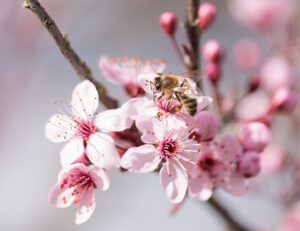

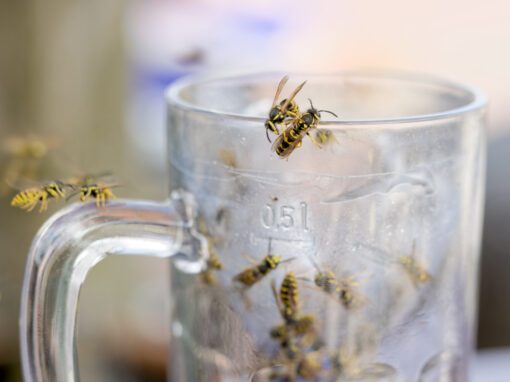

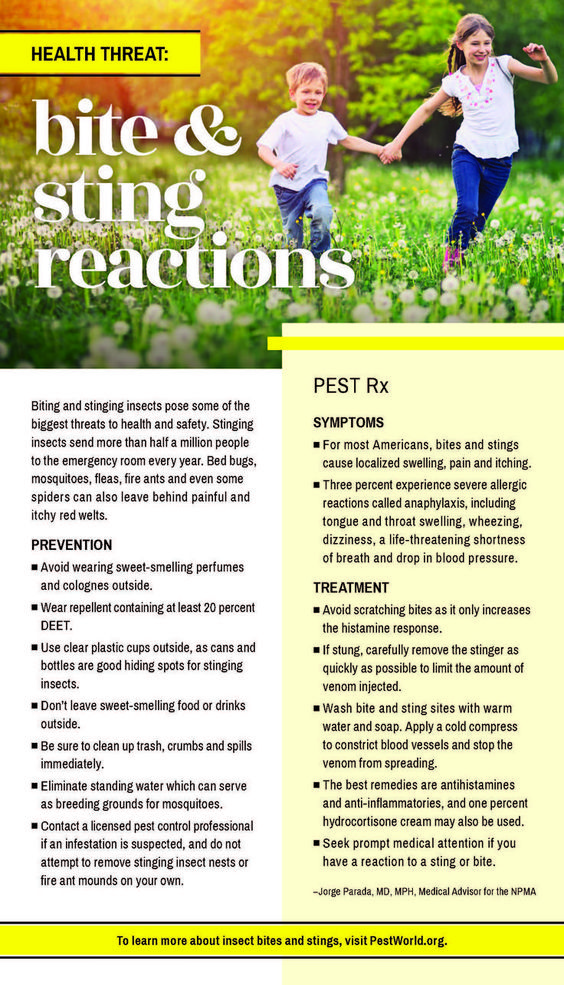
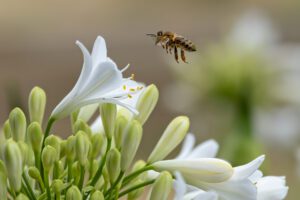
 Bumblebees are fuzzy, social insects that commonly nest in old rodent burrows in the ground. They collect nectar and pollen from flowers to eat and feed their young. They’re loud buzzers, but peaceful bees. Bumblebees rarely sting unless their underground nests are threatened. Here’s a cute fact about the bumblebee: it will “cheat” at collecting nectar and bite the bottoms of flowers instead of entering through the top! We love CHONKY BEES!
Bumblebees are fuzzy, social insects that commonly nest in old rodent burrows in the ground. They collect nectar and pollen from flowers to eat and feed their young. They’re loud buzzers, but peaceful bees. Bumblebees rarely sting unless their underground nests are threatened. Here’s a cute fact about the bumblebee: it will “cheat” at collecting nectar and bite the bottoms of flowers instead of entering through the top! We love CHONKY BEES!